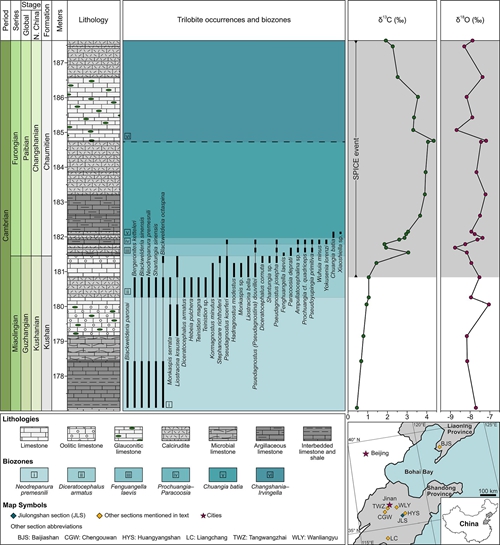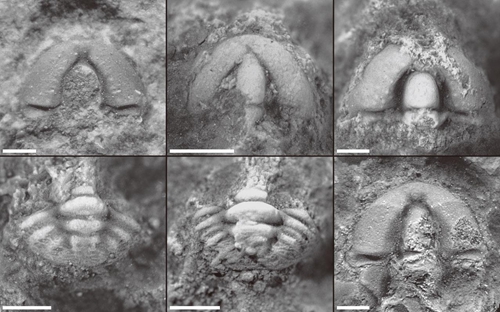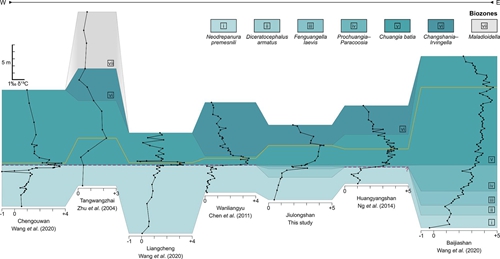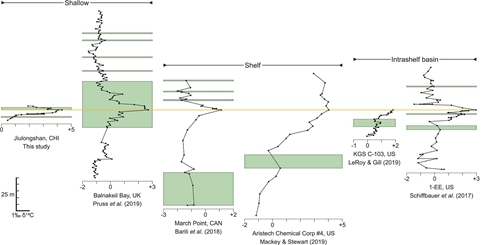Cambrian in South China is mainly composed of sedimentary clastic rocks of slope facies, and trilobites are mostly globose fossils distributed globally, which is convenient for global comparison. A new Cambrian stratigraphic framework has been established in South China, and the framework of geological times for the global Cambrian stratigraphic division has also been formed. However, the Cambrian System in North China is mainly composed of carbonate rocks of shallow platform facies, and trilobites are mainly local molecules (regional fossils). It is the lack of preserved or identified biostratigraphic marker fauna, coupled with the two plates belong to different sedimentary environments, which leads to the difficulty of accurate stratigraphic division and correlation between the two different facies areas for a long time.
Carbon isotope stratigraphy can accurately compare the carbonate facies with the global stratigraphic correlation. Therefore, through the carbon isotope stratigraphy of carbonate rocks and the biostratigraphy of shallow platform facies, the accurate division and multiple correlation of biostratigraphy / chronological strata in two different facies areas can be carried out.
In order to solve this problem, with the support of the Opening Foundation of the State Key Laboratory of Palaeobiology and Stratigraphy, Dr MENG Fanwei (corresponding author), Professor YUAN jinliang of Nanjing Institute of Geological and Palaeontology, Chinese Academy of Sciences (NIGPAS), and Professor schiffbauer J D (co-corresponding author) of the University of Missouri, USA, cooperated with Professor REN Guangying (specially hired) of Linyi University, China, conducted a geological investigation on more than ten sections of late Cambrian in Shandong Province, North China, and a large number of fossils and rock samples were collected. Based on the comprehensive research of biostratigraphy, petrostratigraphy, chronological stratigraphy and geochemistry, the high-resolution carbon isotope stratigraphy was studied, The SPICE (steptoean positive carbon isotope exception) event between the Miaolingian and Furongian series boundaries is identified in North China. The research results have been published online in the well-known international Paleontological journal Lethia.
The study found that, the positive drift of carbon isotopes is better than previous data of δ 13C drift profile is more complete, which reflects the regional changes of paleoenvironment / sea level in the region and the similarities and differences with global changes. It explains that the Jiulongshan section, Gushan and Chaomidian Formation belong to the shallow platform paleoenvironment, but the sea water of the Paleoenvironment represented by this profile is deeper than that of other areas of Shandong Province, North China. In addition, Fenghuangella laevis Park and Choi, 2011, an iconic species, was found on the boundary layer of Jiulongshan section. It was found for the first time in China. This discovery of the fossil provides a strong evidence for the division and comparison of the boundary between the Miaolingian and Furongian series, Cambrian. At the same time, the first appearance datum (FAD) of "species" was established for the first time in the Kushan Formation of North China platform; The problem of the contrast between the platform facies of North China and the boundary of Miaolingian and Furongian Series in the South China slope facies is solved.
This research is supported by the Opening Foundation of the State Key Laboratory of Palaeobiology and Stratigraphy.
Reference: Ren, G., Meng, F., Pulsipher, M. A., Schiffbauer, J. D., Yuan, J., Zhao, Y., Guo, Y., Gao,J., & Chang, C., 2021. A contiguous record of the SPICE event, sea level change and the first appearance of Fenghuangella laevis in Shandong Province, North China. Lethaia, https://doi.org/10.1111/let.12425.

Fig. 1. Stratigraphical column, biostratigraphical ranges and geochemical data of the measured portion of
the Jiulongshan section, Shandong Province, North China

Fig. 2. Photographs of example Fenghuangella laevis specimens recovered from the Jiulongshan section

Fig. 3. Comparative δ13C profiles of the Jiulongshan section versus other SPICE sections in Shandong
and Liaoning Provinces, North China

Fig. 4. Comparative δ13C profiles of the Jiulongshan section versus other glauconite‐bearing SPICE sections from Laurentia
Download:
